Ports and Waterways
- Water transport is the cheapest and the oldest mode of transport. It operates on a natural track and hence does not require huge capital investment in the construction and maintenance of its track except in case of canals.
- Water transport has played a very significant role in bringing different parts of the world closer and is indispensable to foreign trade.
Water transport advantages
- Cheapest means of transport:
- Rivers are a natural highway that does not require any cost of construction and maintenance.
- Even the cost of construction and maintenance of canals is much less or they are used, not only for transport purposes but also for irrigation, etc. Moreover, the cost of operation of inland water transport is very low.
- Thus, it is the cheapest mode of transport for carrying goods from one place to another.
- Least consumption of energy: Waterways are a fuel-efficient and environment-friendly mode of transportation. The boats and steamers, even if mechanized, consume much lesser fuel and do not pollute the surrounding
- Suitable for heavy bulky goods: Waterway can carry much larger quantities of heavy and bulky goods such as coal, and, timber, etc
- No friction: Since the boats and steamers flow in the direction of water the friction force is less as compared to road and railways.
- Eco-friendly: The boats and steamers consume much lesser fuel and do not pollute the surrounding.
Limitations of inland waterways in India
- In India, it rains heavily during monsoons, so the water current is so torrential that it is difficult to ply boats.
- During the dry winter & summer season, most rivers run dry, not even have sufficient water for irrigation, so navigation is hindered.
- River’s of south India flow is rocky areas. Hence they are not fit for plying boats because of waterfalls.
- As compared to boats, railways are quicker & reliable means of transport.
- Since Indian rivers falls from the shallow and sandy delta’s so ships cannot sail from seashores to inland parts.
- But inland water transport has the inherent advantage of cheap means of transport, especially for more load and long journey’s. One horsepower can carry 4000 kg load in water whereas it can carry 150 kg & 500 kg load by road & rail respectively, moreover water transport is less polluting.
Role of inland water transport is Regional development
- The river water transport can contribute significantly in the regional development of the country. This is the cheapest mode of transport and except in the maintenance of ports, Jetties, canals, not much money is involved in its maintenance.
- During the pre-colonial period, inland water transport played a major part in the “Growth of trade” and “regional development in north India. Even today it can play an important role in reducing the production cost of industries.
- There are some regions like the deltaic regions of Ganga where it is difficult and costly to construct roads and bridges across numerous distributaries, river waterway can be a good mode of transport, facilitating the economic development of the region.
- In fact, rural water transport (RWT), a specific sub-sector of inland water transport (IWT) is particularly imp due to its potential to help reduce isolation and poverty. It mostly consists of small family-owned boats that operate on river’s and canal networks, such boats transport service, employment & promote fishing and additional employment is generated in boat making.
Types of Waterways
Inland water ways
- Inland water transport consists of transport by rivers, canals, and lakes. Inland waterway is a network of rivers, canals, backwaters, and creeks that can be utilized for transportation instead of or in addition to roads and rails. Some of the facts related to the Inland waterway are:
- It is the cheapest mode of transport
- It has stiff competition from roadways and railways
- Water diversion from the rivers causes navigation difficult making the Inland waterway less competitive.
- The total navigable length of the inland waterway is 14500 km, out of which about 5200 km of river and 4000 km of canals can be used by mechanized crafts Account for 1% of transport
- Out of 3700 km of navigable rivers which are available for transport, only 2000 km is actually used.
- Canals are controlled by Inland Water Way Authority. The Inland Waterways Authority of India Act, 1985 empowers the Government to declare waterways with potential for the development of shipping and navigation as National Waterways.
Ocean-transport
- Ocean transport is indispensable for foreign trade. It has brought the different parts of the world closer and has knitted together all the nations of the world into one big world market.
- It operates on a natural track, i.e., the sea, and does not require any investment in the construction and maintenance of its track.
- Ocean transport includes coastal shipping and overseas shipping.
National Waterways
National Waterways Act came into effect in 2016. It proposed 106 additional National Waterways and merges 5 existing Acts which were declared the 6 National Waterways which are as follows:
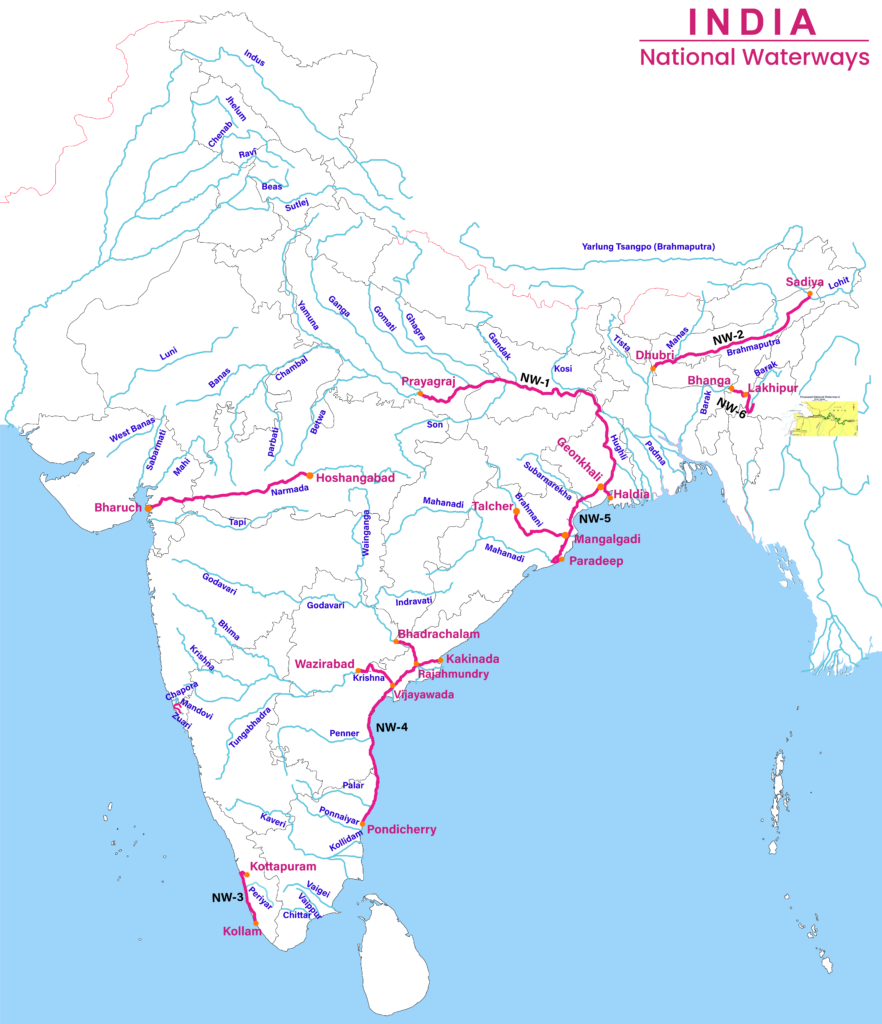
- National Waterways 1 or NW1
- It starts from Allahabad(Prayagraj) to Haldia with a distance of 1620 km.
- The NW 1 run through the Ganges, Bhagirathi, and Hooghly river system with having fixed terminals at Haldia, Farrakka, and Patna and floating terminals at most of the riverside cities like Kolkata, Bhagalpur, Varanasi, and Allahabad.
- It is be the longest National Waterways in India.
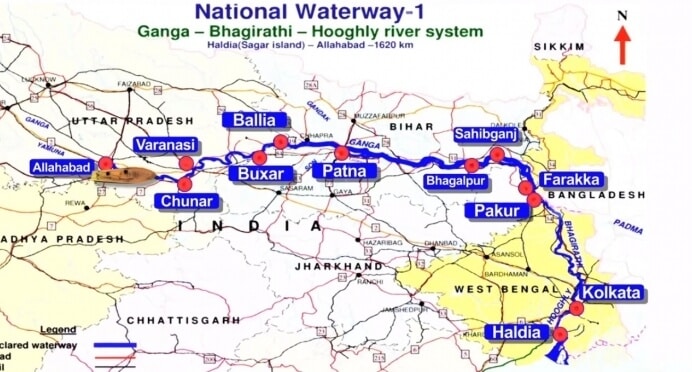
- National Waterways 2
- It is a stretch on the Brahmaputra river from Sadiya to Dhubri in Assam state.
- The NW 2 is one of the major freight transportation waterways of northeast India and the third-longest Waterways with and a total length of 891 km.
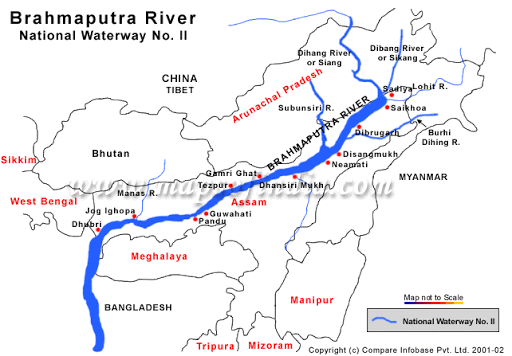
- National waterways 3 or the West Coast Canal
- It is located in Kerala state and runs from Kollam to Kottapuram.
- The 205 km long West Coast Canal is India’s first waterway with all-time navigation facility.
- The NW3 is consists of the West Coast Canal, Champakara Canal, and Udyogmandal Canal and runs through Kottappuram, Cherthala, Thrikkunnapuzha Kollam, and Alappuzha.
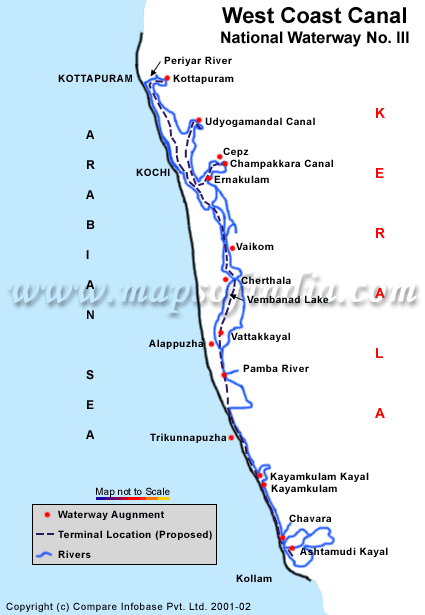
- National Waterway 4
- It is connected from Kakinada to Pondicherry through Canals, Tank, and River Godavari along with Krishna river.
- The NW 4 the second-longest waterway of India with a total length of 1095 km in Andhra Pradesh and Tamil Nadu.
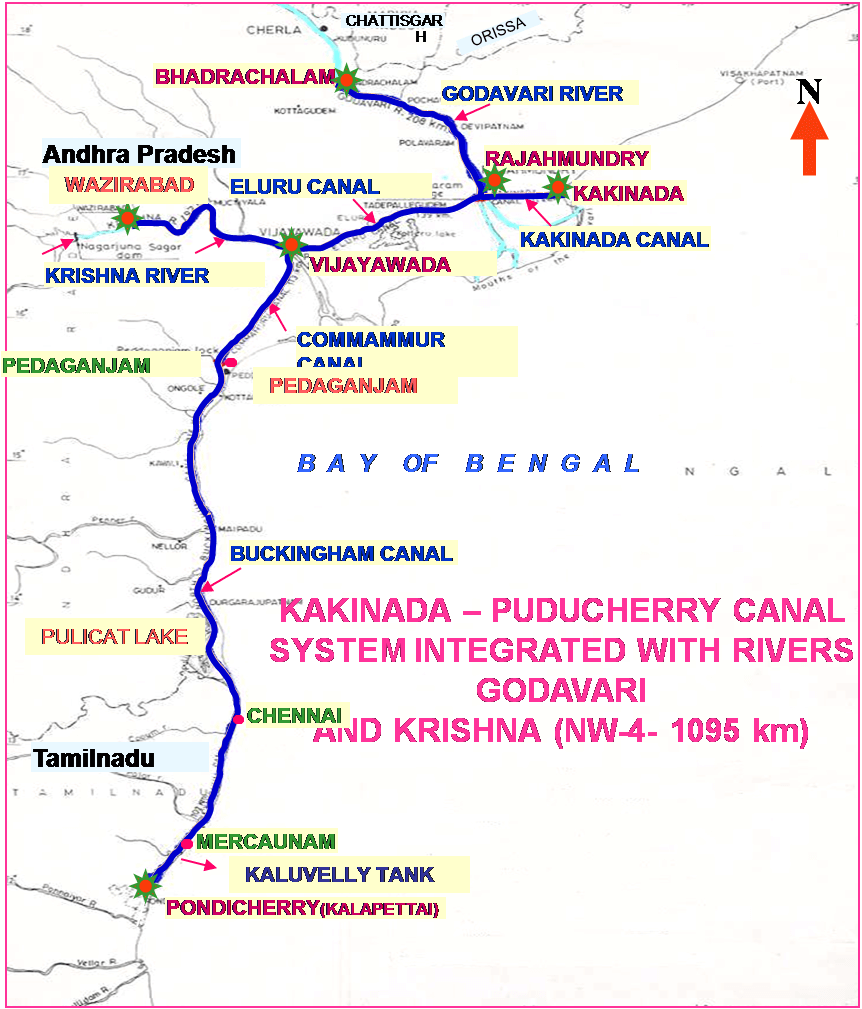
- National Waterway 5
- It connects Orissa to West Bengal using the stretch on Brahmani River, East Coast Canal, Matai river, and Mahanadi River Delta.
- The 623 km long canal system will handle the traffic of cargo such as coal, fertilizer, cement, and iron.
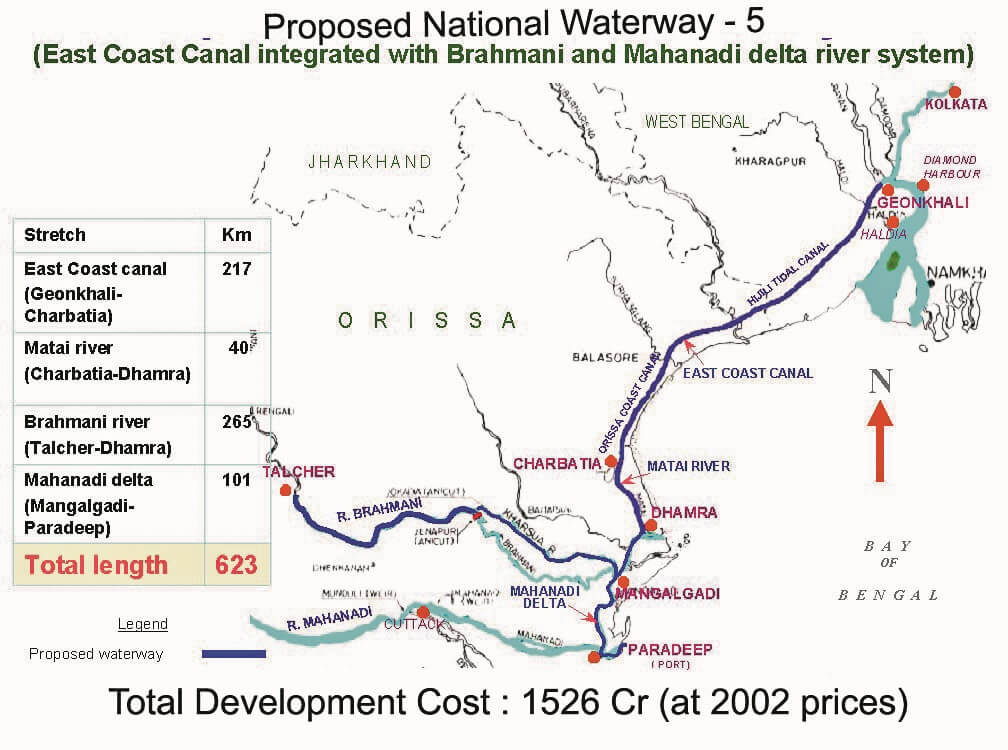
- National waterway 6
- It is the proposed waterway in Assam state and will connect Lakhipur to Bhanga in river Barak.
- The 121 km long waterway will help in trading between the town of Silchar to Mizoram State.

Ocean routes and Ports
- India has a coastline of about 7517 km.
- There are 13 major ports and 200 minor ports. 95% of India’s foreign trade and 70% of the value is trade takes place through seaways.
- Over 7500 kilometers of coastline with 13 major and 60 operational non-major ports.
- 90% of the country’s trade by volume and 70% by value are moved through maritime transport.
- There are 13 major ports in India that handle approximately 58% of cargo traffic.
- Cargo handled at major ports is bulk (44% – iron ore, coal, and fertilizer), liquid (33% petrol, oil, and lubricants), and container (23%).
- There are 13 major ports in the country; 7 on the Eastern coast and 6 on the Western coast. Further, there are about 200 non-major ports.
- The major ports of India are:
- Kolkata Port
- Only riverine major port in India.
- Known for twin dock systems viz, Kolkata Dock System (KDS) on the eastern bank and Haldia Dock Complex (HDC) on the western bank of river Hooghly.
- Paradip Port
- It is an artificial, deep-water port on the East coast of India in the Jagatsinghpur district of Odisha. Located at the confluence of river Mahanadi in Bay of Bengal in Odisha.
- It was the first major port on East Coast commissioned in independent India.
- New Mangalore Port
- Located at a side called Panambur in Karnataka at Gurupura river confluence with the Arabian Sea.
- Cochin Port
- Located on the Willington island on the South – West coast of India
- Located on the crossroads of the East-West Ocean trade.
- The port is called the natural gateway to the vast industrial and agricultural produce markets of South – West India.
- Jawaharlal Nehru Port
- It is also known as Nhava Sheva and is the largest container port in India, handling around half of the containers of all major ports.
- It is located on the eastern shore of Mumbai harbour off Elephanta Island and is accessed via Thane Creek.
- Vadhavan Port
- This will be 13th major port in India.
- With the development of this port, India will become one of the countries in the top-10 container ports in the world.
- A special purpose vehicle (SPV) will be formed with Jawaharlal Nehru Port Trust (JNPT) as the lead partner, with equity participation equal to or more than 50% to implement the project.
- The port will be developed on the landlord model.
- Vadhavan port has been planned by the JNPT as an ‘All Weather, All Cargo’ satellite port to enhance capabilities in handling deep draft ships and larger vessels.
- Mumbai Port
- One of the oldest modern ports of India. Initially, the location was used by the navies of Shivaji.
- Kandla Port
- Kandla port was built after partition as the Karachi port on the western coast had gone to Pakistan. It is known for handling much of the crude oil imports of India.
- Vishakhapatnam Port
- Vizag port is located in Andhra Pradesh and is known for the bulk of cargo handling on the east coast.
- Chennai Port
- Chennai Port is the largest port in the Bay of Bengal and the second largest port of India after JNPT. It is the largest port at the east coast.
- Tuticorin Port
- This port has been now renamed as V.O. Chidambaranar Port. It is located in the Gulf of Mannar. V.O.Chidambaram Port is an artificial port.
- Tuticorin is the only port in South India to provide a direct weekly container service to the United States.
- Ennore Port
- This port is now named as Kamarajar Port Limited. It is the first corporate port of India and is registered as a public company with 68% stake held by the government.
- Mormugao Port
- Mormugao port in Goa is the leading iron ore exporting port of India.
- Kolkata Port
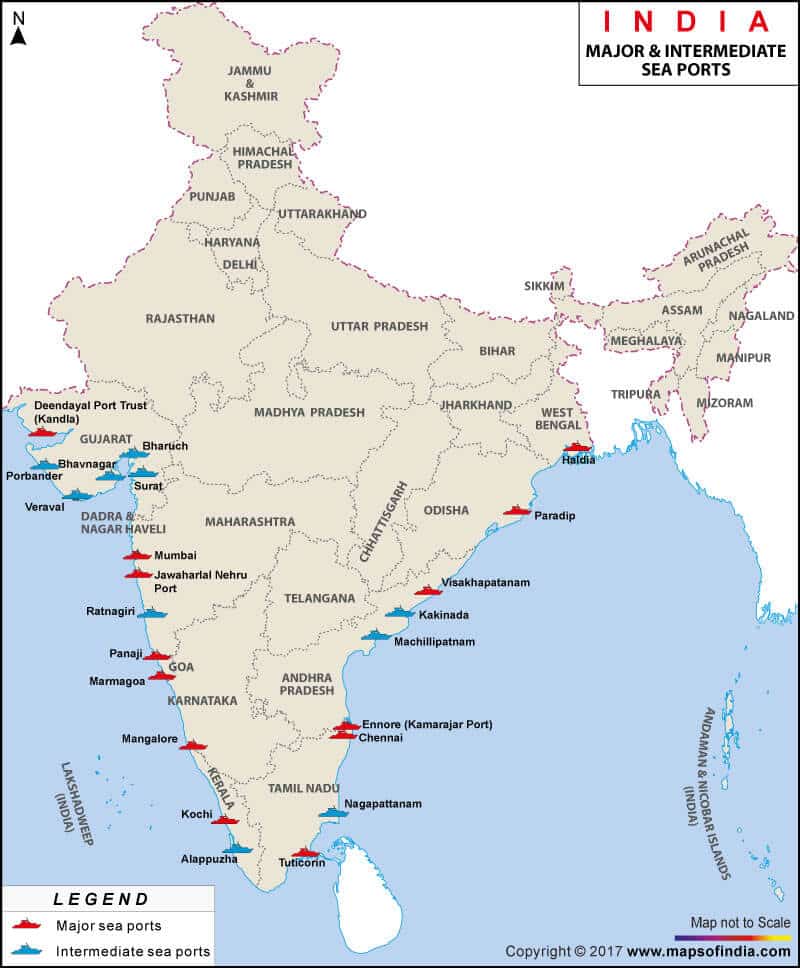

thanks sir
also provide industries notes…
Sure, Visit this category – https://lotusarise.com/category/geography-optional/industry/
tq sir
I would like to recommend this site to everyone who needs this..
So kind of you, Thanks
Thank you so much for every notes (in one comment sorry for that).
thank u so much …
The notes provided by you saves a large amount of time of the students. Very thankful sir for providing such colourful illustrative notes to students. Please do tell if we could contribute in monetary form so you can continue this goodwill.
this site is superb